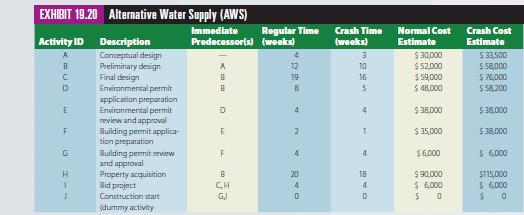Gordon Rivers, the city manager of Saratoga, Florida, pitched the proposed design schedule back at Jay Andrews.
Question:
Gordon Rivers, the city manager of Saratoga, Florida, pitched the proposed design schedule back at Jay Andrews. Jay Andrews is the project manager for Major Design Corporation (MDC). The city of Saratoga selected MDC for this project. As project manager, it is Jay’s responsibility to assemble the technical team necessary to complete the project, develop and track the budget, establish and maintain the schedule, allocate resources as required, and manage the project until completion. “We need the intake and transmission main designed, bid, and completed in 35 weeks. The city of Saratoga has a future \($2\) million dollar federal grant riding on the project getting done on time,” Mr. Rivers said. Jay nodded in agreement. Mr. Rivers continued by saying, “Jay, the project needs to come in on schedule and within the budget. Now take this schedule back and figure out how we are going to do it.” Major Design Corporation is a 3,500- employee firm with annual revenues of more than \($1\) billion. The firm is divided into five geographically based global sales divisions, an engineering/technical services division based in the United States, and a wholly owned construction company. MDC offers full services—consulting, engineering, construction, and operations— across the “project life cycle” for water, environment, transportation, energy, and facility resources. MDC was selected by the city of Saratoga to design a new, 10-million-gallon-per-day surface water intake and transmission main. The intake withdraws water from a canal and pumps it more than two miles to the city’s wastewater treatment plant. There, the canal water is blended with reclaimed water (i.e., treated sewage water) and distributed back to customers for irrigation purposes. This project is touted as an “alternative” water supply project because the water source is not a historically used source. The project will increase the long-term sustainability of the city because it will diversify the city’s water supply portfolio and recycle water. The project will also minimize the need for additional withdrawals from historic water sources, which have become less productive and more highly regulated in the past 10 years, as the city’s population continues to grow. Other green benefits of the project include reduced environmental impacts on the historic water sources and a reduced carbon footprint, as the irrigation water requires less energy-intensive treatment than the city’s other drinkable water sources. The objective of the project is to design a fully functional surface water intake that is protective of the environment, will last at least 30 years, and will have a low life-cycle cost (i.e., capital, maintenance, and energy consumption). For this type of project, engineering design accounts for 20 percent of total project cost. The design stage is also important because the decisions made during design lock in 80 percent or more of the life-cycle costs of the project. As a result, engineers take a holistic approach when selecting equipment and features for projects. A piece of equipment, for example, that is inexpensive upfront may have significant, long-term maintenance costs. The following narrative describes the main activities required to complete the AWS project. Exhibit 19.20 provides project work activities, precedence relationships, and costs.
The project will begin with the development of a conceptual design (activity A). During the conceptual design, engineers confirm the applicable regulations and laws for the project, including sustainability criteria; perform evaluations of alternative equipment; identify site conditions and constraints; and develop initial facility and equipment layouts.
Once the conceptual design is complete and MDC has received feedback on it from the city of Saratoga, preliminary design (B) begins. Preliminary design expands the design based on the preferences and constraints identified during the conceptual design. The preliminary design finalizes the project design criteria (e.g., sizing, operational capacity, reliability, and sustainability) and incorporates them (along with additional geotechnical, survey, and environmental findings) into preliminary drawings and written specifications. Drawings and specifications are the key information-intensive products that come out of this work. The drawings show how the project will look when constructed, and the specifications provide detailed guidance and criteria by which the construction is to proceed. For this project, the completion of the preliminary design allows three other parallel tasks to begin: final design (C), environmental permit application preparation (D), and property acquisition (H). Final design is a continuation of the preliminary design stage. In final design, additional information is added to the specifications. Environmental permit application preparation (D) involves taking certain drawings from the preliminary design and modifying them to illustrate the controls included in the project to minimize environmental impacts. To receive a permit, the engineers must demonstrate that the project will have little to no impact on the environment and be constructed in accordance with applicable laws. Typical impacts engineers try to prevent include storm water runoff from the site, pollutant discharges from the site, uncontrolled emissions from equipment, destruction of natural habitats, and displacement of endangered species. Once the environmental permit application is complete, it is submitted to a regulatory agency for review. This activity, identified as environmental permit review and approval (E), does not require any work on the part of the MDC engineers, but cannot be crashed because an outside entity is responsible for it. Property acquisition (H) starts with the identification of all properties on which the project sits or passes through. For the properties identified that the city doesn’t currently own, the city must acquire rights to use the properties. There are two ways the city can obtain these rights. The first is to find a willing seller—a property owner who, for a price, will turn over certain property rights to the city. The second is through condemnation. Condemnation is a lengthy legal process by which the city can take the property rights from the owner by demonstrating to a court that the project serves the public good and that there are no other viable alternatives. Upon approval of the environmental permit, the engineers can begin work on preparing the building permit application (F). This task involves filling out the application form and compiling the necessary sheets from the drawing set to illustrate that the project will be constructed to the latest local, state, and federal building codes. When the application has been completed, it is submitted to the appropriate government entities for building permit review and approval (G). During the review, the MDC engineer is not required to do any work, but, similar to the environmental permit, nothing can be done to make the review go quicker because it is done by an outside party. When the final design is complete and the building permit is issued, the city can bid the project (I). Bidding the project involves advertising the project in the local newspaper and online. Contractors interested in building the project obtain a copy of the project drawings and specifications from the city.
Based on what they see in the drawings and how they interpret the specifications, each interested contractor then develops a bid that will be low enough to win the project while still allowing for a reasonable profit. During the bidding stage, MDC will assist the city by responding to contractor questions, holding a meeting to discuss the project with potential contractors (known as pre-bid meetings), and holding site visits of the actual construction site so the contractors can get a better understanding of the conditions they will face if they win the job. At the end of the bidding period, the contractors submit their bids in sealed envelopes to the city of Saratoga. The city opens the bids and compares the submissions. The apparent low bid will be sent to MDC for review. MDC will review both the dollar amount of the bid and the other documents (e.g., drawings, references, insurance, specifications, and bonds) included in the submittal. If a low bidder has not completed the other documents properly, it is deemed nonresponsive, and the engineer begins review of the next lowest bid. This process continues until the lowest responsive bidder is identified. The bid phase ends with MDC’s recommendation to the city as to which qualified contractor should be awarded the job. Immediately following the bid phase, as long as the building permit has been issued, construction can start (J). This dummy activity has an activity time of zero. The construction start is a milestone that designates the end of the engineering design phase of the project and the beginning of the construction phase (another project).

Case Questions for Discussion:
1.Draw the project network, and determine the normal time to complete the project, activity slack times, the critical path(s), and total project costs (i.e., baseline your project), using the Critical Path Method.
2.Determine the best way to crash the project to complete it in 35 weeks with revised activity slack times, critical path(s), and total project costs. Provide reasoning as to how all crashing decisions were made.
3.Activity times with the greatest uncertainty are activities D, E, and H. Describe conceptually how you could model this uncertainty in activity times. (You do not have the necessary data to actually do this numerically.)
4.What are your final recommendations?
Step by Step Answer:

Operations And Supply Chain Management
ISBN: 9780357901649
3rd Edition
Authors: David A. Collier; James Evans




